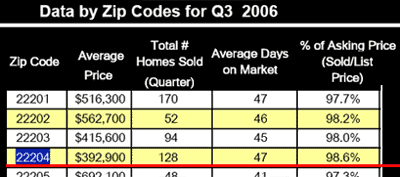MRIS data, Average Sold/List Ratio: 98.6% or 92.2%?
Update: a Part 2 link is at the bottom.
MRIS stands for Metropolitan Regional Information Systems. They are the company that provides the Washington DC area MLS system for all Realtors. They also provide data to consumers and the press to reveal how the market is doing. The only problem is that the data is limited and can easily be misinterpreted without giving proper clarification.

So I set out to recreate the numbers and I finally think that I understand how they came up with their data. I don’t question whether the data is correct, I just question how it is presented.
I believe now that the “% of Asking Price” means the “% of the last and lowest asking list price to the sold price, excluding seller subsidies.” So if a house was initially listed at:
Hypothetical example:
$600,000 Starting Price
$500,000 Lowered List Price
$495,000 Contract price
$10,000 Seller subsidy (about average for 22204)
________
$485,000 Net (counting the $10,000)
= a 1% drop using MRIS’s data
= a 20% drop from the top number.
So if you were to include the subsidy and the starting price, the price drop would be almost 20% lower, yet this hypothetical numbers would be reported by the MRIS as a 1% drop ($500k to $495k).
So back to recreating the actual numbers from MRIS. (My Excel document is available upon request.)
I took all homes for the period of 7/01/06 to 9/30/06. I found 72. This number is off from their their 128, I’m not sure why.
From this data I was able to come very close to recreating their numbers (option 1 below).
1) % of Final list price was 98.4% (vs their 98.6%, no big deal).
2) % of Final list price MINUS seller subsidy= 96.8%
3) % of Original list price MINUS seller subsidy= 94.25%
4) % of Highest price (prior Realtor or listing#) MINUS seller subsidy= 92.2%
Using the $600k example from earlier, #3 takes the starting price of $600k and counts the $10,000 seller to make a final closed price of $485,000. However #4 above takes into account if the listing had a prior agent with an even higher price. So with #4 I took the starting price of a house regardless of how many Realtors had tried to sell it, or how many times one Realtor relisted it to reset the Days on the Market.
So while the MRIS data is not necessarily incorrect, the public should know that it does NOT mean that the average house in that zip code only dropped 1.4% from what the seller started with. That number is probably closer to an 8% drop once you count the seller subsidy (which was near 0 a couple years ago) and the initial starting price.
Recalculated drop for 22204: 8% (92.2% of the starting list price, including subsidies)
Conclusion: Don’t assume information that is given to you is correct, question how the numbers are compiled.
Update: I have a Part 2 on this posting: Part 2: Illegal MLS Fudging. 20% Chance You’ll See 1.
And make sure you see the 22 other blogs on shady agent tricks and things that buyers should be aware of. Blog.FranklyRealty.com
– Written by Frank Borges LL0SA- Broker/Owner FranklyRealty.com
703-827-4006
Videos at YouTube.FranklyRealty.com
Keywords: DOM DOMM DOMP CDOM Days on the Market, Housing bubble? Arlington, Alexandria, MLS MRIS, search, Homes, Real estate, Virginia, Alexandria, 22201, 22314, Fairfax Va, DC Realty, Realtor
- 12
- December
- 2006



Good work dude. Appreciate the effort.
I am so pleased to see an industry person who understands that bad information, as opposed to negative press, is what scares buyers. There are good opportunites in any market, as long as people understand where the market is at.
Bogus stats like 98.6% hurts delusional sellers who think that if they hang in there long enough, they too will get their asking price.
I’m glad you are looking at and scrutinizing the stats. What the public is fed is filled with errors and is incomprehensible- it’s no wonder so many people are choosing to stay on the sidelines.
[…] found that the average MLS listed home in Northern Virginia drops 8% (including seller subsidy, see older post) from the real first MLS listed price (sorry, but no public MLS system shows the starting price if […]